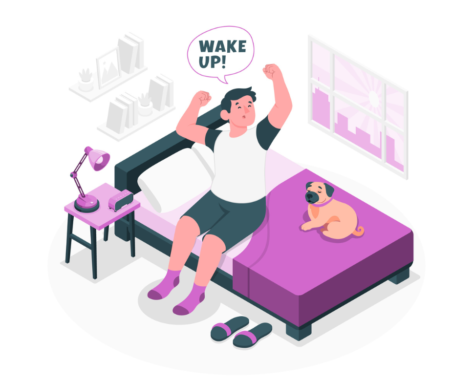LESSON OVERVIEW
The main objectives of this lesson plan for A1 English learners are to:
- learn and practise morning routine vocabulary;
- explore adverbs of frequency to talk about habits and behaviours;
- share personal routines and discuss the routines of others.
With this lesson plan for A1 English learners, students discuss what they do in the morning! They learn morning routine vocabulary and practise their listening skills. Students also learn and practise adverbs of frequency (often, usually, never, sometimes, in the evening). They share their own routines and guess their teacher’s and their classmates’ habits! Students also discuss morning habits around the world and give some insights about their own country.
WARM-UP AND VOCABULARY
This lesson plan for A1 English learners begins with a warm-up. Students look at a word cloud and choose three words that describe the word ‘morning’ to them. After that, they use words from the word cloud to complete multiple phrases about morning routines (e.g. drink coffee, make coffee; learn English, learn the guitar). Following that, learners read some sentences describing various morning routines and complete them with the correct phrases. Afterwards, students look at some morning routine activities and choose which ones they do in the morning. They put them in order and write five sentences about themselves. Next, students listen to some recordings and match the professions to the speakers. Then, they read some statements and listen to the recordings again to see if the statements are true or false.
ADVERBS OF FREQUENCY AND DISCUSSION
This part of the lesson for A1 English learners focuses on adverbs of frequency (often, usually, never, sometimes, in the evening). Students read sentences from the recordings and put them on a scale of how often people do something. After that, students read some information about the people and guess who the main sentence is about based on the adverbs of frequency. Following that, they use the adverbs of frequency to describe their own habits. Next, students describe some pictures using morning routine vocabulary and adverbs of frequency. They also have to write three sentences guessing their teacher’s morning routine. Then, students tell their partner how often they do certain things in the morning. Together, they find two things that are the same for both of them and share them with the class. After that, students complete statements about morning habits around the world with the correct word. The lesson finishes with an exercise in which students write some sentences about people in their country.
HOMEWORK/REVISION
This lesson plan also includes an additional task that you can use as homework or revision. Students need to write seven sentences using some words in the boxes. The task is available in the teacher’s version of the worksheet. You can print it and hand it out to your students. It’s also included in the e-lesson plan.
WORKSHEETS
Subscribe to unlock these and many other Standalone lesson with the Premium plan
Subscribe











Nice!!!!! I’m so glad you guys are providing A1 lessons now!
Thanks! We’re excited to have A1 lessons too 🙂
Hey guys! I don’t know if you’ve realized it, but there’s a little mistake on slide 14. It says the cook is the speaker 3, but actually it’s speaker 2, I believe.
Hi! You’re right, thanks for noticing! We have fixed it 🙂
Great lesson. But for us, my institution and according to the European Framework of Languages, this lesson is more like A2 or elementary. A1 is complete beginner, the ones who start from scratch.
I see the same difference in other lessons – what you call B2 is more like a C1 for us – especially the videos. Not a big problem, activities can always be adapted to fit the level.
Thank you for your feedback! We appreciate your perspective on the levels. Our A1 lessons are designed for Elementary or False Beginner students rather than absolute beginners (A0), which might explain the difference. We aim to align with the CEFR guidelines as closely as possible, but we understand that interpretations can vary. We’re glad to hear that you find the lessons adaptable!
I agree with the comment above. I’ve prepared students for Cambridge exams for years so I’m very familiar with CEFR levels. The problem I find with the lessons sometimes is that the instructions for the activities are too difficult for them to understand. Students who have such a low level need to be able to understand the instructions. The concepts are easy but the instructions or the activity is too advanced. With that being said, ESL Brains is my favorite teaching resource and I use it every single day. I absolutely love it.
Thank you for your feedback! We’ll work on simplifying the instructions as much as we can. We want to keep activities varied and interesting, which sometimes requires using less common instructions. We’re also preparing a lesson that focuses on teaching instruction words, which should help.
We’re glad you love using ESL Brains every day 😊
Wow! It’s amazing to see your providing A1 lessons. My students are loving it and So am I.
That’s fantastic to hear! We’re so glad you and your students are enjoying our A1 lessons😊
Thank you for launching A1 lessons! Greetings from Chile 🇨🇱
Thanks so much😊
I love the lessons, but I would love to have a speed option for the audio recordings. They are very fast for beginners.
Thanks! You can actually change the speed of the audio on YouTube. Just go to Settings – Playback speed and select 0.75.
Great! Thanks so much!